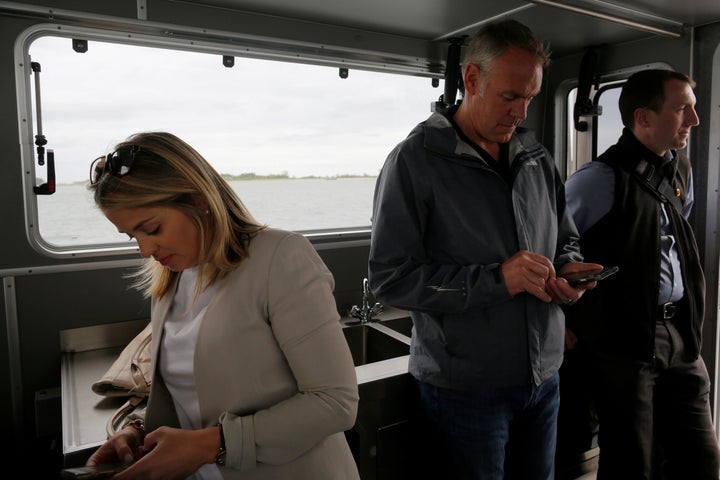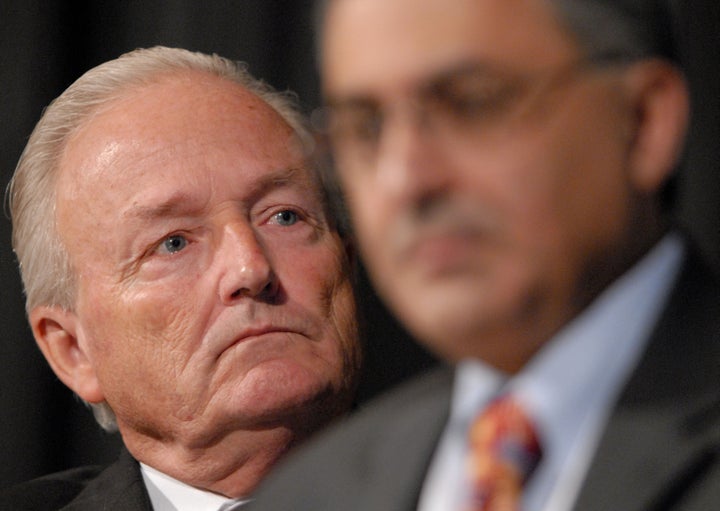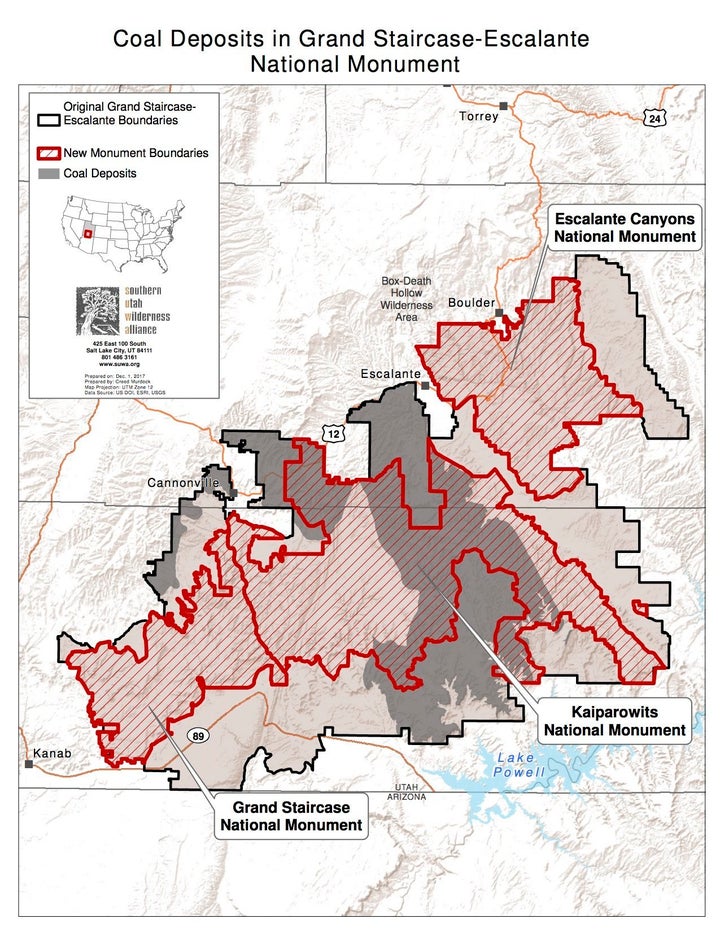
WASHINGTON — This month, on the recommendation of his Interior secretary, President Donald Trump gutted a pair of protected national monuments in Utah, including coal-rich Grand Staircase-Escalante. The decision followed the controversial review of more than two dozen national monuments ― a process that public records reveal to have been overseen by the daughter of Frederick Palmer, the former executive of coal giant Peabody Energy and a current senior fellow at the conservative Heartland Institute.
Downey Magallanes, Palmer’s daughter, is a 2012 graduate of the Georgetown University Law Center who worked for seven years as a staffer for Sen. Roy Blunt (R-Mo.) and now serves as Interior Secretary Ryan Zinke’s deputy chief of staff for policy. Magallanes was at Zinke’s side throughout his months-long monuments review. And her personal calendar shows she had several one-on-one meetings with Zinke to discuss the review in the days before Aug. 24, when Zinke submitted his draft report to the White House.
A version of that report was leaked to the media in September, and the Interior Department released the final version earlier this month. It calls on Trump to shrink or otherwise weaken protections for 10 monuments. On Dec. 4, Trump signed a pair of proclamations to reduce the size of the two Utah sites by a combined 2 million acres. The 1.87 million-acre Grand Staircase-Escalante National Monument, the largest land monument in the country, was cut roughly in half. The boundary of Bears Ears National Monument, a 1.35 million-acre landscape named after a pair of buttes and home to thousands of Native American archeological and cultural sites, was shrunk by about 85 percent.
The move, which opens the door for mining, drilling and other industrial development on public land that has been off limits to such activities, was quickly met with numerous lawsuits from Native American tribes and conservation groups. Meanwhile, groups like the Heartland Institute, a right-wing think tank that’s loaded with climate change deniers and furiously promotes the use of fossil fuels, rejoiced.
Interior Department schedules and visitor logs make clear that Magallanes was a key figure in the agency’s review. She was on hand during a press call in April, when Zinke first announced details of Trump’s executive orders that initially threatened the future of 27 national monuments. During the briefing, Zinke introduced Magallanes as his adviser and said she was there to “help me answer questions if I cannot field them.”
Magallanes traveled with Zinke to several monuments, including Grand Staircase-Escalante and Bears Ears, as part of his monuments “listening tour.” While at Grand Staircase-Escalante, Zinke tweeted a photo of himself and others gazing at an exposed coal seam.
On Aug. 1, roughly three weeks before Zinke submitted his report to the White House, Magallanes joined Zinke and Trump for a private lunch at the White House, according to Zinke’s schedule. The following day she and Zinke returned to the White House for the first of two monuments review meetings. Attending that meeting and a second on Aug. 29 were White House deputy chief of staff Rick Dearborn, White House Cabinet Secretary Bill McGinley and other high-level officials.
Palmer said Thursday that he is well aware and extremely proud of his daughter’s work at the agency, including her lead role in the monuments review, and supports the administration’s recent rollbacks.
But he stressed he was not involved, either directly or indirectly.
“I didn’t have any skin in that game in any way, shape or form,” he told HuffPost.
“I do know that Downey Palmer Magallanes has recused herself from anything having to do with Peabody,” Palmer said. “That I know for a fact. So she’s not a problem there. She’s a lawyer. And she’s a lawyer that follows the rules.”
But the record would appear to suggest that Magallanes has in fact been involved with Peabody on at least one occasion.
Schedules show Magallanes was among three Interior officials who joined Zinke on a June 5 video call with representatives of her father’s former employer — roughly a month after she and Zinke’s visit to Grand Staircase-Escalante.

At the meeting from Peabody were Glenn Kellow, president and CEO; Michael Flannigan, senior vice president of government affairs; and Ray Shepherd, vice president of federal government relations.
The purpose of that call remains unclear. Michelle Constantine, a spokeswoman for Peabody, did not answer HuffPost’s specific questions about the June 5 meeting. “Peabody Energy meets with elected officials, policy makers, and other stakeholders on a regular basis to discuss important public policy issues,” she wrote in an email.
Neither the Interior Department nor Magallanes responded to HuffPost’s inquiries about her role in the monuments review, the June 5 meeting or whether she has indeed recused herself from Interior’s dealings with Peabody.
Asked about the meeting of Peabody and Interior officials, Palmer said he had no knowledge of it. He did note that the coal company is talking to Interior as part of its ongoing effort to extend the life of the Navajo Generating Station, a massive coal-fired power plant on the Navajo Indian Reservation in Arizona. Peabody supplies the power plant with coal from the Kayenta Mine, also located on tribal land.
Palmer said his daughter’s recusal with matters concerning Peabody included anything having to do with the Navajo power plant.

Like other government agencies, the Interior Department requires employees to recuse themselves from matters that present conflicts of interest and the appearance of conflicts. Specific situations requiring recusal include those that will have an effect on financial interests; when seeking other employment; “when an employee’s participation in a matter would create an appearance problem;” and “out of an abundance of caution.”
Virginia Canter, the executive branch ethics counsel at Citizens for Responsibility and Ethics in Washington, a government watchdog group, told HuffPost that given Magallanes’s familial ties to the longtime Peabody executive, it would have been prudent for her to seek advice from an agency’s ethics office and have them determine if it was appropriate for her to meet with company officials. “I suspect that an agency ethics official [would say] that the potential conflict may be a little too attenuated,” since her father is no longer with the company, Canter said.
Peabody does not appear to have any historic or newfound interest in mining the Grand Staircase-Escalante area, which contains vast deposits of coal. Still, it’s a resource that struggling coal companies like Peabody might see as a future opportunity.
In a 1994 report, the U.S. Geological Survey estimated that more than 62 billion tons of coal — of which 11.4 billion tons are recoverable — are located in the Kaiparowits Plateau.

Trump’s proclamation removed large sections of the plateau from the monument. Extractive industries have targeted the area for development in the past. In the 1990s, Andalex Resources, Inc. proposed the Smoky Hollow Mine — a giant operation that sought to remove some 72 million tons of coal worth an estimated $1.4 billion over a 30-year period.
Palmer — who spent 37 years in the coal industry, 14 years of them as the senior vice president of government relations at Peabody — said he doubts that the presence of coal influenced the agency’s decision on Grand Staircase-Escalante.
“Hell man, there’s coal everywhere. That’s why we use it,” he said. “That Grand Staircase coal, I’ve never looked at those reserves. And I’ve never heard anybody talking about developing the reserves.”
The monument rollbacks were about maintaining public land for a variety of uses, including but not limited to mining, Palmer said. He noted that there is also grazing ground and uranium on the land.
“This was not some deep secret coal deal,” he said of Trump’s monument decision. “It’s a multiple-use issue.”
Others, however, see it as yet another giveaway to energy interests from an administration stacked with industry lobbyists and climate change skeptics, and which is working feverishly to boost fossil fuel production in an effort to achieve what it calls “energy dominance.”
Land Tawney, president and chief executive of the Montana-based nonprofit Backcountry Hunters and Anglers, told Politico this month that the administration’s decision on Grand Staircase-Escalante was particularly “troubling.” He called it a “carve-out for the coal industry” that threatens important habitat for bighorn sheep.
Public lands advocates say Magallanes’ ties to the coal industry should raise questions about her involvement in the monuments review and Zinke’s recommendations to Trump.
Greg Zimmerman, deputy director of the Center for Western Priorities, a Colorado-based conservation and advocacy group, told HuffPost that like many Interior officials under Zinke or in his inner circle, Magallanes “seems happily committed to carrying out a far-right agenda for public lands: increasing access for private corporations, while cutting out the public from our lands.”
“The national monument review is Exhibit A,” he said.
As part of the review, Magallanes also met extensively with members of Utah’s Republican congressional delegation and their staffers, as well as several other state and local officials opposed to the monuments, her schedule shows. She participated in calls with numerous Republican lawmakers in other states with monuments impacted by the review. And she met with several industry representatives, including the vice president of operations at Energy Fuels Resources, a uranium company that lobbied Trump to carve up Bears Ears so that it could access the area’s uranium deposits, as The Washington Post first reported.
And when Trump and Zinke traveled to Salt Lake City earlier this month to announce their decision on Bears Ears and Grand Staircase-Escalante, Magallanes joined them aboard Air Force One, her father told HuffPost.
In addition to reducing the Utah sites, Zinke has recommended that Trump shrink the boundaries of two land monuments, Nevada’s Gold Butte and Cascade-Siskiyou in Oregon and California, as well as consider reducing the size of a pair of marine national monuments ― Pacific Remote Islands and Rose Atoll. His report also calls for sweeping changes in how these protected sites are managed, including allowing for drilling, mining, grazing, logging and commercial fishing.
Trump has described the monument designations of his predecessors, specifically President Barack Obama, as an “egregious abuse of federal power” that locks up federal land and threatens local economies. But many conservationists see the Trump administration’s review of monument designations as an illegal attack on the unilateral powers the Antiquities Act of 1906 grants to presidents. Sixteen presidents, both Republicans and Democrats, have used the law to designate 157 monuments. And there is no legal precedent that establishes the president’s authority to abolish, shrink or otherwise weaken national monuments.
Zinke — who at Trump’s proclamation signing this month said “no one loves public land more than I” — has swung back at accusations that the administration is rolling back public lands protections on behalf of the fossil fuel industry. And he has attacked Patagonia, an outspoken critic of the monuments review, dismissing the outdoor retail company as a “special interest” that makes its products in China.
“Not one square inch of land has been transferred or sold,” Zinke told reporters a day after Trump’s announcement in Utah, as The Oregonian reported. “This is not about energy. There is no oil and gas assets.”
But in his final report to the White House, Zinke acknowledged the potential for mining coal in Grand Staircase-Escalante.
“Areas encompassed within [Grand Staircase-Escalante National Monument] contain an estimated several billion tons of coal,” the report reads.
Since assuming the helm at Interior, Zinke has repeatedly stressed that he and Trump don’t pick winners and losers, but rather favor “an all-of-the-above energy strategy.” But he’s met privately with a slew of oil and gas executives, spoken at industry conferences and a trade group’s board meeting, and prioritizes energy development over conservation. He’s done all of this while virtually turning a cold shoulder to solar, wind and other renewables.
In early April, just over a month into Zinke’s tenure, the Interior Department came under fire when it temporarily changed the banner image on the Bureau of Land Management’s website from a picture of two boys enjoying nature to a towering coal seam at Peabody’s North Antelope Rochelle Mine in Wyoming.
